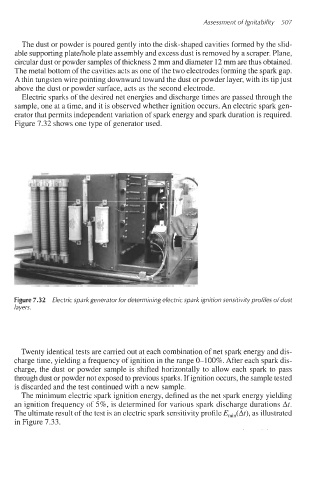Page 540 - Dust Explosions in the Process Industries
P. 540
Assessment of lgnitability 507
The dust or powder is poured gently into the disk-shaped cavities formed by the slid-
able supporting platehole plate assembly and excess dust is removed by a scraper. Plane,
circular dust or powder samples of thickness 2 mm and diameter 12 mrn are thus obtained.
The metal bottom of the cavities acts as one of the two electrodes forming the spark gap.
A thin tungsten wire pointing downward toward the dust or powder layer, with its tip just
above the dust or powder surface, acts as the second electrode.
Electric sparks of the desired net energies and discharge times are passed through the
sample, one at a time, and it is observed whether ignition occurs. An electric spark gen-
erator that permits independent variation of spark energy and spark duration is required.
Figure 7.32 shows one type of generator used.
Figure 7.32 Electric spark generator for determining electric spark ignition sensitivity profiles of dust
layers.
Twenty identical tests are carried out at each combination of net spark energy and dis-
charge time, yielding a frequency of ignition in the range 0-100%. After each spark dis-
charge, the dust or powder sample is shifted horizontally to allow each spark to pass
through dust or powder not exposed to previous sparks. If ignition occurs, the sample tested
is discarded and the test continued with a new sample.
The minimum electric spark ignition energy, defined as the net spark energy yielding
an ignition frequency of 5%, is determined for various spark discharge durations At.
as
The ultimate result of the test is an electric spark sensitivity profile E~n(At), illustrated
in Figure 7.33.

